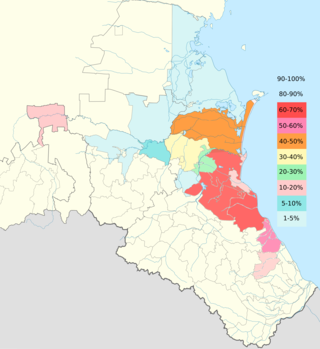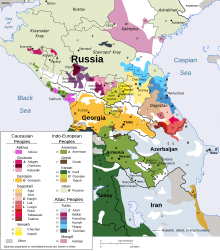

| Kumyk | |
|---|---|
| къумукъ тил qumuq til • قموق تیل | |

| |
| Native to | North Caucasus |
| Region | Dagestan, Chechnya, North Ossetia |
| Ethnicity | Kumyks |
Native speakers | 450,000 (2010 census)[1] |
| |
| Cyrillic, Latin, Arabic | |
| Official status | |
Official language in | Dagestan (Russia) |
| Language codes | |
| ISO 639-2 | kum |
| ISO 639-3 | kum |
| Glottolog | kumy1244 |
 Share of the Kumyk population in areas of traditional residence in the Caucasus according to the 2010 census | |
| This article contains IPA phonetic symbols. Without proper rendering support, you may see question marks, boxes, or other symbols instead of Unicode characters. For an introductory guide on IPA symbols, see Help:IPA. | |

| External videos | |
|---|---|
A series of videos about the similarities of languages
| |
Kumyk (къумукъ тил,[2] qumuq til,[3] قموق تیل[4][5]) is a Turkic language spoken by about 426,212 people, mainly by the Kumyks, in the Dagestan, North Ossetia and Chechen republics of the Russian Federation.[6] Until the 20th century Kumyk was the lingua franca of the Northern Caucasus.
Kumyk language belongs to the Kipchak-Cuman subfamily of the Kipchak family of the Turkic languages. It's a descendant of the Cuman language, with likely influence from the Khazar language,[7] and in addition contains words from the Bulghar and Oghuz substratum.[7] The closest languages to Kumyk are Karachay-Balkar, Crimean Tatar, and Karaim languages.[8]
Nikolay Baskakov, based on a 12th-century scripture named Codex Cumanicus, included modern Kumyk, Karachai-Balkar, Crimean Tatar, Karaim, and the language of Mamluk Kipchaks in the linguistic family of the Cuman-Kipchak language. Samoylovich also considered Cuman-Kipchak close to Kumyk and Karachai-Balkar.[9]
Amongst the dialects of the Kumyk there are Kaitag, Terek (Güçük-yurt and Braguny), Buynaksk (Temir-Khan-Shura) and Xasavyurt. The latter two became basis for the literary language.[10]
Kumyk had been a lingua-franca of the bigger part of the Northern Caucasus, from Dagestan to Kabarda, until the 1930s[11][12][13] and was an official language of communication between the North-Eastern Caucasian nations and the Russian administration.[14]
In 1848, a professor of the "Caucasian Tatar" (Kumyk) Timofey Makarov published the first ever grammatical book in the Russian language for one of the Northern Caucasian languages, which was international Kumyk. Makarov wrote:[15]
From the peoples speaking Tatar language I liked the most Kumyks, as for their language's distinction and precision, so for their closeness to the European civilization, but most importantly, I take in account that they live on the Left Flank of the Caucasian Front, where we're conducting military actions, and where all the peoples, apart from their own language, speak also Kumyk.
More than 90% of the Kumyks, according to 2010 census, also speak Russian, and those in Turkey and the Levant speak Turkish and Arabic.[citation needed]
| Front | Back | |||
|---|---|---|---|---|
| Close | i ⟨и⟩ | y ⟨уь⟩ | ɯ ⟨ы⟩ | u ⟨у⟩ |
| Mid | e ⟨e⟩ | ø ⟨оь⟩ | o ⟨o⟩ | |
| Open | æ ⟨ә⟩ | a ⟨a⟩ | ||
| Labial | Dental | Palatal | Velar | Uvular | Glottal | ||
|---|---|---|---|---|---|---|---|
| Nasal | m ⟨м⟩ | n ⟨н⟩ | ŋ ⟨нг⟩ | (ɴ) ⟨нг⟩ | |||
| Plosive/ Affricate |
voiceless | p ⟨п⟩ | t ⟨т⟩ | tʃ ⟨ч⟩ | k ⟨к⟩ | q ⟨къ⟩[a] | |
| voiced | b ⟨б⟩ | d ⟨д⟩ | dʒ ⟨дж⟩ | ɡ ⟨г⟩ | (ɢ) ⟨къ⟩[a] | ||
| Fricative | voiceless | f ⟨ф⟩ | s ⟨c⟩ | ʃ ⟨ш⟩ | χ ⟨x⟩ | h ⟨гь⟩ | |
| voiced | β ⟨в⟩ | z ⟨з⟩ | ʒ ⟨ж⟩ | ʁ ⟨гъ⟩ | |||
| Liquid | rhotic | r ⟨p⟩ | |||||
| lateral | l ⟨л⟩ | ||||||
| Semivowel | j ⟨й⟩ | ||||||
Kumyk has been used as a literary language in Dagestan and Caucasus for some time.[when?] During the 20th century the writing system of the language was changed twice: in 1929, the traditional Arabic script (called ajam) was first replaced by a Latin script, which was then replaced in 1938 by a Cyrillic script.

| A a | B b | C c | Ç ç | D d | E e | F f | G g |
| Ƣ ƣ | H h | I i | J j | K k | L l | M m | N n |
| Ꞑ ꞑ | O o | Ɵ ɵ | P p | Q q | R r | S s | Ꞩ ꞩ |
| T t | U u | V v | X x | Y y | Z z | Ƶ ƶ | Ь ь |
| А а | Б б | В в | Г г | Гъ гъ | Гь гь | Д д | Е е |
| Ё ё | Ж ж | З з | И и | Й й | К к | Къ къ | Л л |
| М м | Н н | Нг нг | О о | Оь оь | П п | Р р | С с |
| Т т | У у | Уь уь | Ф ф | Х х | Ц ц | Ч ч | Ш ш |
| Щ щ | Ъ ъ | Ы ы | Ь ь | Э э | Ю ю | Я я |
| Arabic alphabet 1921—1928 |
Latin 1928—1938 |
Cyrillic c 1938 |
Latin project 1991 |
IPA |
|---|---|---|---|---|
| ا | A a | А а | A a, Ä ä | /a/, /æ/ |
| ب | B ʙ | Б б | B b | /b/ |
| و, ۋ | V v | В в | V v, W w | /v/, /w/ |
| گ | G g | Г г | G g | /g/ |
| غ | Ƣ ƣ | Гъ гъ | Ğ ğ | /ʁ/ |
| ه | H h | Гь гь | H h | /h/ |
| د | D d | Д д | D d | /d/ |
| - | Je je, e | Е е | Ye ye, E e | |
| - | Ө ө | Ё ё | Yo yo, Ö ö | |
| ج, ژ | Ƶ ƶ, Ç ç | Ж ж | C c, J j | /d͡ʒ/, /ʒ/ |
| ز | Z z | З з | Z z | /z/ |
| ى | I i | И и | İ i | /i/ |
| ى | J j | Й й | Y y | /j/ |
| ک | K k | К к | K k | /k/ |
| ق | Q q | Къ къ | Q q | /q/ |
| ل | L l | Л л | L l | /l/ |
| م | M m | М м | M m | /m/ |
| ن | N n | Н н | N n | /n/ |
| نگ,ڭ | Ꞑ ꞑ | Нг нг | Ñ ñ | /ŋ/ |
| ۉ | O o | О о | O o | /o/ |
| ۊ | Ө ө | Оь оь | Ö ö | /ø/ |
| پ | P p | П п | P p | /p/ |
| ر | R r | Р р | R r | /r/ |
| س | S s | С с | S s | /s/ |
| ت | T t | Т т | T t | /t/ |
| و | U u | У у | U u | /u/ |
| ۏ | Y y | Уь уь | Ü ü | /y/ |
| ف | F f | Ф ф | F f | /f/ |
| خ | X x | Х х | X x | /x/ |
| تس | S̷ s̷ | Ц ц | Ts ts | |
| چ | C c | Ч ч | Ç ç | /t͡ʃ/ |
| ش | Ş ş | Ш ш | Ş ş | /ʃ/ |
| Щ щ | Şç şç | |||
| ء | ' | Ъ ъ | ' | /ʔ/, /ʕ/ |
| ى | Ь ь | Ы ы | I ı | /ɯ/ |
| Ь ь | ||||
| ه | E e | Э э | E e | /e/, /æ/ |
| Ju ju | Ю ю | Yu yu, Ü ü | ||
| Ja ja | Я я | Ya ya, Ä ä | /æ/ |
Irchi Kazak (Ийрчы Къазакъ Yırçı Qazaq; born 1839) is usually considered to be the greatest poet of the Kumyk language. The first regular Kumyk newspapers and magazines appeared in 1917–18 under the editorship of Kumyk poet, writer, translator, and theatre figure Temirbolat Biybolatov (Temirbolat Biybolat). Currently, the newspaper Ёлдаш (Yoldash, "Companion"), the successor of the Soviet-era Ленин ёлу (Lenin yolu, "Lenin's Path"), prints around 5,000 copies 3 times a week.[citation needed]
The Kumyk language was learned by Russian classical authors such as Leo Tolstoy[19] and Mikhail Lermontov,[20] both of whom served in the Caucasus. The language is present in such works of Tolstoy as "The Raid",[21] Cossacks,[22] Hadji Murat, and Lermontov's - "A Hero of Our Time",[23][20] Bestuzhev-Marlinsky's - "Molla-nur" and "Ammalat-bek".
{{cite news}}: CS1 maint: date and year (link)
{{cite book}}: CS1 maint: location missing publisher (link)
|
| |||||||||||||||||||||||||||||||||||||||||||||
|---|---|---|---|---|---|---|---|---|---|---|---|---|---|---|---|---|---|---|---|---|---|---|---|---|---|---|---|---|---|---|---|---|---|---|---|---|---|---|---|---|---|---|---|---|---|
| Proto-language |
| ||||||||||||||||||||||||||||||||||||||||||||
| Common Turkic |
| ||||||||||||||||||||||||||||||||||||||||||||
| Oghur |
| ||||||||||||||||||||||||||||||||||||||||||||
| Disputed classification |
| ||||||||||||||||||||||||||||||||||||||||||||
| Creoles and pidgins |
| ||||||||||||||||||||||||||||||||||||||||||||
| |||||||||||||||||||||||||||||||||||||||||||||
|
| ||||||||||||||||||||
|---|---|---|---|---|---|---|---|---|---|---|---|---|---|---|---|---|---|---|---|---|
| Caucasian (areal) |
| |||||||||||||||||||
| Indo- European |
| |||||||||||||||||||
| Turkic |
| |||||||||||||||||||
| Others |
| |||||||||||||||||||
| ||||||||||||||||||||
|
| |
|---|---|
| Federal language |
|
| State languages of federal subjects |
|
| Languages with official status |
|
| Scripts |
|
1 In Russia, the Cyrillic alphabet is officially supported. 2 For other, non-Cyrillic alphabets, separate federal laws are required. | |
| Authority control databases: National |
|
|---|